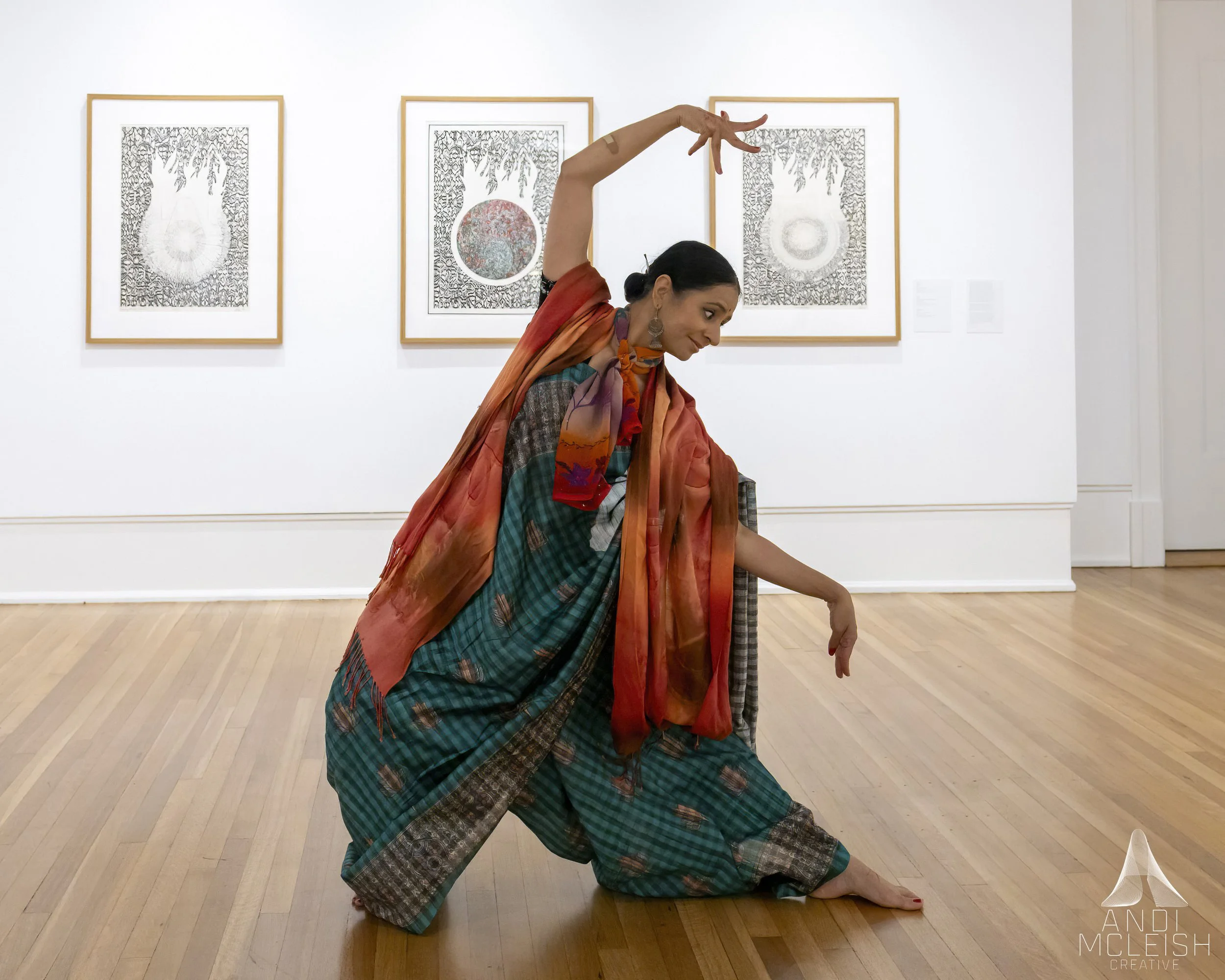MAINSTAGE 2025-2026
Trei
Vidya Kotamraju
Photo: Andi McLeish
Trei
Trei (“three”) is a solo dance work by Vidya Kotamraju, blending the codified intricacy of South Asian form of Bharata Natyam with contemporary gesture, rhythmic play, and meditative stillness. Inspired by the contemplative worlds of visual artists, Trei asks: What becomes visible when we slow down enough to truly see?
Through a choreography of sustained attention and subtle transformation, the piece invites audiences into a charged space of presence, where every glance, shift, and pause holds meaning. Movement, silence, and breath become tools for reframing perception itself: how we look, what we overlook, and how the body can serve as both witness and canvas.
Trei is inherently adaptable. In black-box theatres, its sculpted lighting creates painterly shadow and texture. In galleries and museums, the work engages in dialogue with surrounding objects and artworks, allowing their forms, colours, and spatial arrangements to influence its pathways, costuming and gestures. Outdoors, in courtyards, gardens, or public squares, natural light, wind, and ambient sound enter the score, introducing an element of chance that shifts audience attention and alters the performer’s pacing and phrasing.
These site-responsive iterations transform Trei into an ever-evolving encounter between dancer, environment, and viewer. Whether performed under a proscenium arch, beside a sculpture, or in the open air, the work remains a quiet yet potent meditation on slowness, attention, and connection.
Fully rehearsed, technically minimal, and ready to tour, Trei offers presenters a versatile, tour-ready work that speaks across cultural and disciplinary boundaries, opening an intimate, shared space for seeing and being seen.
Vidya Kotamraju
Vidya Kotamraju is a dance artist, choreographer, and educator based on the unceded territories of the MST Nations (Vancouver). She is the founder of House of Indian Dance, a platform dedicated to the learning and presentation of culturally grounded movement.
Her choreography reimagines Bharatanatyam for contemporary audiences, merging classical discipline with global influences, storytelling, and expressive physicality. Through her work, she explores themes of identity, migration, and resilience, creating performances that bridge tradition and modern expression.
Vidya’s works have been featured across Canada at festivals and venues including the Vancouver International Dance Festival, Diwali in BC, Diwalifest, Namaste Canada, and The Dance Centre’s Silk Route Festival. She has been an Artist-in-Residence at The Dance Centre and is a recipient of the Shade of Hope Award. Her training is rooted in mentorship under Jai Govinda (Canada), Bragha Bessell (India), and Sheila Kumar (India).
www.vidyadance.com | Instagram: @vidyakotamraju
Performance History & Upcoming Performances
Trei Performance History:
A Studio Provoked: A Dancer's Response, Burnaby Art Gallery, 2024
Dance in Surrey: Community Showing & Conversation, Surrey Civic Theatres, 2025
Project Created by: Vidya Kotamraju
Key Artistic Collaborators: Soundscape: Vishnu R.
Dance, Choreography, Costume: Vidya Kotamraju
Performance type: THIS WORK IS ADAPTABLE TO THEATRE OR OUTDOORS OR ALTERNATE VENUES /SPACES, THIS WORK IS BUILT FOR OUT-OF-DOORS OR ALTERNATE VENUES/SPACES - (see question below to note specifics), THIS WORK IS BUILT FOR THEATRE
How do you define this work: Dance
Length of performance: 10 to 55 minutes (length adaptable based on presenter needs)
Audience type: General Audience, Other (i.e. audiences who have similar embodied experiences with subject material), Children/Family
General Technical Requirements: Basic sound system with playback capability (laptop or USB)
Required amount of time for tech set up: Standard black-box set-up: 2-4 hours for lighting focus, cueing, sound check, and spacing.
Gallery/museum or outdoor set-up: 1-3 hours for adapting to space, sound check, and environmental adjustments.
Minimal-tech touring version available with 1-2 hour set-up.
Alternative Venues: Trei is adaptable for black-box theatres, galleries, museums, community halls, and outdoor public spaces.
Indoor non-traditional spaces: Clean, level floor (wood, marley, or smooth concrete). Basic sound playback; adjustable lighting ideal but not essential.
Galleries/Museums: Can integrate with existing artworks; adjustable lighting preferred to highlight both performer and objects.
Outdoor settings: Courtyards, gardens, public squares, or waterfronts with flat, even surface. Adapts to natural light, sound, and environmental shifts; evening shows require power for light/sound and weather contingency.
Audience: Flexible; traditional seating, in-the-round, or moving/wandering.
Access needs: Clear pathways, minimal noise bleed, accessible viewing for all audiences.
Number of Performers on tour (including choreographer): 1
Number of Support Staff on Tour: 1
Availabilities: 2025/26 Season, 2026/27 Season
Project Details
Community Engagement
Community Engagement:
Beyond classes, I collaborate with communities to co-create short performance scores inspired by Trei’s exploration of attention and environment. These projects can involve local dancers, musicians, or visual artists in site-specific responses, integrating movement with sound, spoken word, or visual installation.
Outreach Activities
I offer master classes, lecture-demonstrations, and short workshops that introduce Bharata Natyam’s rhythmic, gestural, and expressive language in dialogue with contemporary movement. These sessions are tailored to dance students, multidisciplinary artists, and general public (ages 12+), with options for younger participants in school settings.
Workshops can focus on:
Storytelling through gesture and facial expression (abhinaya)
Rhythm and footwork patterns, adapted for all levels
Improvisation as a bridge between tradition and contemporary practice
Formats range from 60–90 minutes to half-day intensives. For presenters, I can also offer pre or post-show artist talks, contextualizing Trei’s themes of perception, slowness, and site-specific adaptation.

